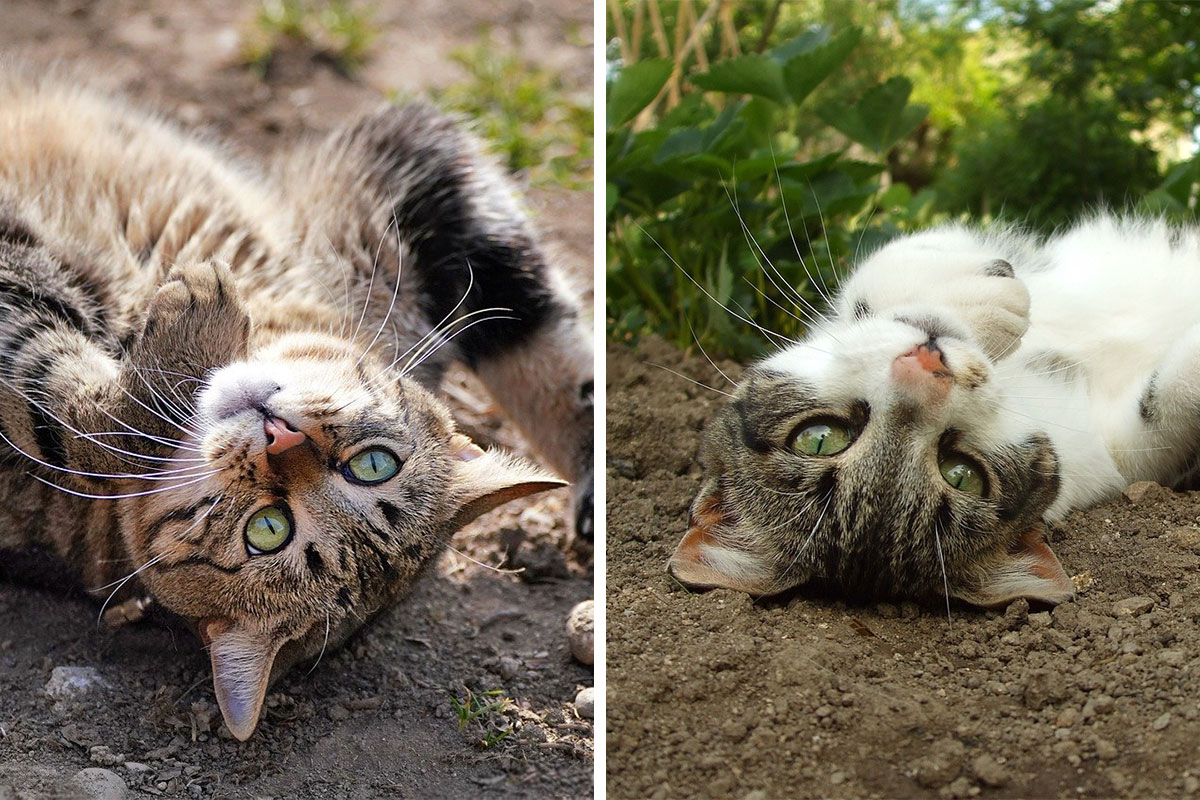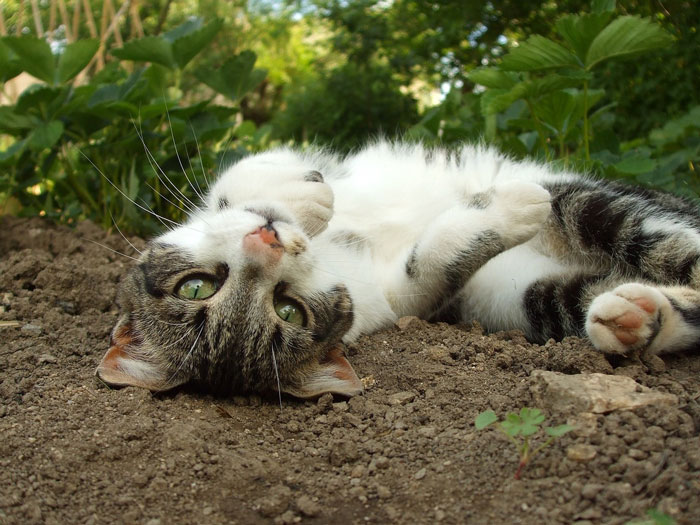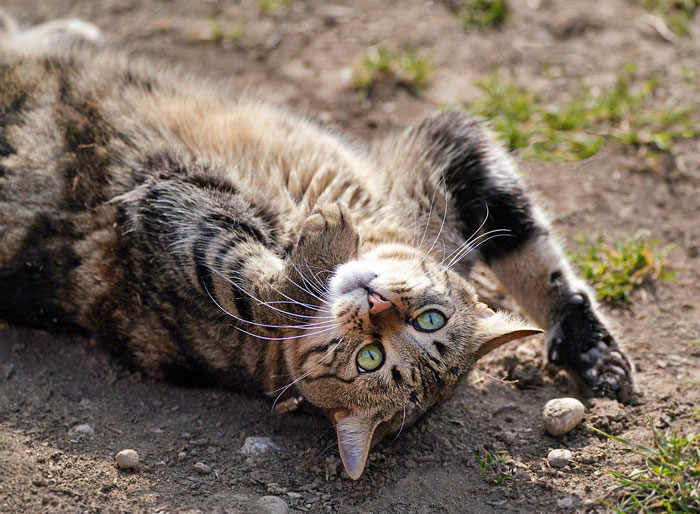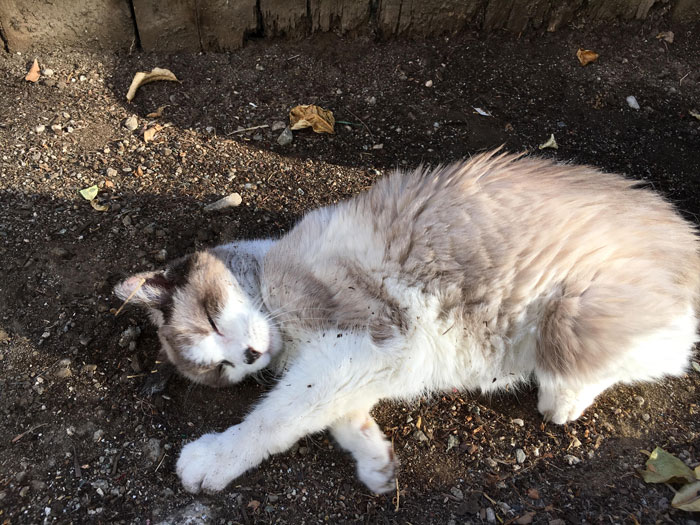
10 Reasons Why Do Cats Roll In Dirt and How to Stop Them
Have you ever wondered why your feline friend enjoys rolling around in the dirt? Are cats just dirty or smelly animals, or is there more to this behavior?
Contrary to common belief, cats are clean animals. They roll in the dirt for many reasons, including play, territory marking, and even courtship. We will discuss the reasons why cats roll in the dirt and all you need to know about this behavior. So, let’s get right into it!
- Cats roll in dirt for reasons like play, territory marking, and cooling off.
- Itching from parasites or skin conditions can cause cats to roll in dirt.
- Rolling in cool, moist soil helps cats regulate their body temperature.
- Cats ingest 'good' bacteria from dirt to aid in digestion and health.
- Female cats may roll in dirt as a mating signal to male cats.
The information provided herein is for informational purposes only. Please refer to our disclaimer for more details..
What is dust bathing?
Dust bathing or rolling in the dirt is a behavior commonly observed in cats. This involves the cat rolling around in the dirt for many possible reasons.
Some felines seem to enjoy this activity, but it can sometimes indicate an underlying issue like improper digestion.
10 reasons why cats roll in the dirt
There are various reasons why your cat may be rolling around in the dirt. It could be to mark their territory, alleviate itchiness, or even ingest good bacteria. Some cats might roll in the dirt to cool off on a hot day or communicate with other cats.
Your cat is itchy
Cats usually roll on the ground when they’re trying to relieve a hard-to-reach itch. Many things, including parasites like fleas or ticks and skin conditions like mange, may cause this itching.
Image credits: elko
If your cat suddenly starts rolling around on the ground and hasn’t had a bath in a while, it may be trying to scratch an itch that it just can’t reach. Rolling in the dirt might help to dislodge the foreign materials or parasites causing this itch. It could also help with the removal of dead skin and loose fur.
Territory marking
Cats have scent glands on different body parts, including their face, paws, and tail base. Sometimes, cats roll on the ground to transfer their pheromones onto that area. This is their way of communicating to other cats that the area is that.
Along with rolling around in the dirt, these cats may rub against things and surfaces in the house like dogs. This behavior is known as scent marking and is common in cats.
Playing
Your kitty might roll around in the dirt simply to entertain itself. Cats are curious animals that love to explore new sensations. Your cat might simply decide to have a dust bath because the dirt has an interesting texture.
Remember that cats are solitary creatures and develop behaviors such as this as a form of self-entertainment.
A cat may also roll in the dirt as a way to initiate play with another cat.
Trying to cool down
If you notice that your cat is rolling around in the dirt on a sunny day, chances are that it’s trying to cool down.
Image credits: ykaiavu
When they’re rolling around, cats remove the top layer of warm soil to reveal the cooler layer underneath. Cats can reduce their body temperature by rolling in excellent moist soil.
It’s a response to catnip
One of the reasons cats suddenly begin to roll in dirt is exposure to catnip. Catnip is a naturally growing herb that contains a compound known as nepetalactone. Cats that ingest this herb can exhibit a wide range of behaviors, including rolling. Cats exposed to catnip might roll for about 10 minutes due to its stimulatory effects.
If you have an outdoor cat that suddenly starts rolling around on the ground, you should consider this possibility. Catnip is non-toxic to cats, and this is usually nothing to worry about.
Seeking attention
Your cat could roll onto the floor to get your attention. Your cat may do cute kitty rolls just to get your reaction. If this is accompanied by rubbing against your legs, you can be sure your cat feels like spending quality time with you.
Trying to cover up its scent
Your cat may take a dust bath to cover up its scent. Domestic cats mimic this behavior from their wild ancestors, who used to roll in dirt to help camouflage themselves from predators and prey. Since cats still retain their hunting instincts, they may still exhibit this behavior.
To aid digestion
Cats sometimes roll in dirt to aid their digestive system. Cats have good bacteria naturally found on their skin, and they eat them when they groom themselves. You might think your cat is gross for doing this, but it helps with digestion.
When you bathe your cat too often, these bacteria will be washed away, affecting digestion. By rolling in dirt, cats pick up bacteria from the soil on their skin. Later, while grooming themselves, they will ingest these bacteria. So, rolling in dirt contributes to the good bacteria needed for gastrointestinal health in cats.
It’s a mating dance
This behavior may be a form of cat communication. Female cats usually roll on their back, sometimes in the dirt, to attract potential mates during the heat period.
Image credits: finalwonders
This shows male cats that they are ready to mate. This behavior is usually accompanied by purring and rubbing against objects.
Stress relief
Some cats turn over in dirt to release pent-up energy and tension. While this may seem counterintuitive, interacting with their environment can help distract them from stressors.
Do cats love rolling in the dirt?
Cats have different personalities. So, while some cats may love to roll in the dirt, others might not. Many cats may enjoy rolling in dirt due to the sensation that they get from dust bathing. Others might just do it to entertain themselves.
However, it’s important to monitor this behavior and address any concerns related to parasite infestations.
Should you let your cat roll in the dirt?
Dust bathing is a natural cat behavior, but it might be a pointer to a health or behavioral issue if you notice your cat rolling frequently. However, if you notice this behavior occasionally, it’s nothing to worry about.
On the other hand, allowing your cat to roll in the dirt too often could pose health risks. In such cases, it’s advisable to discourage this behavior and provide alternative ways to help your cat enjoy its surroundings.
How to stop a cat from rolling in the dirt
If you’re concerned about your cat dust bathing, there are ways to help your feline friend. Here are a few tips to teach your cat to stop rolling in the dirt:
- Keep your cat indoors.
- Redirect the behavior by giving cat toys instead.
- Provide a cool spot for your pet during hot days.
- Consider building a solid cat enclosure, sandbox, or designated area with cat-safe dirt or sand outside. Consult a veterinarian to rule out any underlying health issues that may be causing the behavior.
- Offer regular grooming sessions to keep your cat’s coat clean and healthy.
- Provide plenty of mental and physical stimulation for your cat to decrease the need for dust bathing.
Frequently asked questions
Do cats need to roll in the dirt when they see you?
Cats do not need to roll in the dirt when they see you. The behavior could be triggered by various factors, including playfulness or seeking attention.
What does it mean when your cat rolls in your dirty clothes?
Cats may do this to pick up your scent or mark the item as part of their territory. You may also notice your cat licks your dirty clothes as a comforting behavior, particularly if the scent provides reassurance to them.
Should you let your cat outside?
This decision depends on many factors, such as your cat’s age, lifestyle, and safety concerns. As a general rule, kittens should be up to 5 months before they are allowed to go outside on their own.
They would’ve taken all necessary vaccinations and developed some immunity at this age. There are pros and cons to letting your cat stay inside or go out, so weigh your options carefully.
797views
Share on Facebook
 Dark Mode
Dark Mode 

 No fees, cancel anytime
No fees, cancel anytime 






























0
0